Earthbound Farm, Organic Power Greens, Baby Chard, Kale and Spinach
Growing Vegetables in Straw Bales (Straw is Like a Sponge and Holds an Amazing Quantity of H2o)
Thursday, March x, 2022 12:13
% of readers recall this story is Fact. Add your two cents.
Worries nigh the down economic system and food safety are fueling a boom in abode gardens. However, many people don't want to toil in the garden, or they don't have enough 1000 space.We have the reply: straw bales.
Harbinger bale gardening: is it any good?
Easy, economical and efficient, the humble straw bale is raising the stakes for veg production.
Straw bale gardening is not something I've tried before, but it is on the cards for this year. The technique has been around since the Sixties, if not before. An American horticulturalist, Joel Karsten, has been honing his tillage techniques using this system for 22 years and at present grows almost all his vegetables and herbs this way, using 25 bales to supply his family's needs.
He is evangelical about the technique. In many ways it is similar growing in raised beds without having to brand the raised beds. BBC Radio 4'due south Gardeners' Question Time has had numerous queries from schools and clubs hoping to abound crops on difficult surfaces or flat roofs, and this is mayhap the least expensive and most effective organization without having to elevator the concrete or tarmac.
Karsten reckons that veg and fruit plants are about 25 per cent more than productive in bales than they are in the ground. This can be attributed to more than oxygen to the roots (we are increasingly realising the importance of this), together with unlimited water (harbinger is like a sponge and holds an astonishing quantity of water) and nutrients. Added to this, oestrus from decomposition of the harbinger means that crops are produced before, the cropping period is extended later in the year, as well, and the produce is by and large larger. Karsten calculates that 75 per cent less labour is involved – bales never need weeding.
The nearly labour-intensive part is the initial "conditioning" – adding water and fertiliser so the bales offset to decompose inside, which takes about 10-14 days. On the first twenty-four hour period you spread 4oz of a nitrogen-rich backyard fertiliser evenly over the top before gently washing it in with 1-2 gallons of water (this takes a minute or so). The fertiliser does not need totally washing in. When h2o is coming out of the bottom, stop. For the adjacent nine days or and then you lot carry on, some days adding fertiliser, some days not. If you are organic, y'all tin add together organic fertiliser instead but increase the quantity six fold (and source organic straw). After the fifth day use water from a barrel or water that has been left in a bucket overnight so it is not every bit common cold equally from the tap. Finally, immediately earlier planting, add a seep hose along the top (if yous don't want to hand h2o) and on the 11th mean solar day plant or sow.
Sowing involves spreading a 1-2in layer of multi-purpose compost forth the entire summit of the bale, before sowing the seeds. As for planting, you just stab the firsthand surface area with a trowel to make a pigsty broad enough to receive the plug/pot and button the plant in. Remove a small bit of straw if necessary. I plan to constitute 3 tomato plants per bale and will probably add some marigolds to assist deter whitefly, and might well institute parsley up the sides, too.
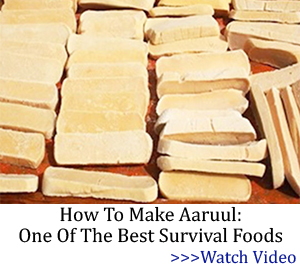
Karsten even grows potatoes this way (three plants per bale) – they are clean on harvesting, extremely easy and highly productive, and then I am tempted. My thin, limey soil means potatoes are decumbent to scab, only the bales' moisture-rich environment volition help foreclose this. Sweetcorn, notwithstanding, is not ideal – this is a huge constitute and can only exist grown two per bale, so it is inappreciably worth it. Perennial vegetables are out of the question, too, as the bales will last for a maximum of two years. After this they become mushy but are keen for compost or adding to borders. Otherwise, parsnips, turnips, lettuce – indeed, just about everything – volition grow. Every bit to watering interval, a grower in North Carolina practical just a gallon a week per bale during drought periods and null suffered. Soluble fertiliser is added every few weeks.
What to abound
You can grow crops from seed or establish seedlings — simply as you would in a raised bed or in the basis. For seedlings, consider tomatoes, eggplants, peppers and spring greens. If you're planting from seed, start with beans, cucumbers and squash. Carrots, beets, sugariness potatoes and potatoes can exist grown well but are a flake trickier.
How to fix the bales
Before you can establish in the bales, they demand some special training, and so purchase the bales at least ii weeks before y'all want to institute. Place the bales where you lot want to grow; once they are prepared, they will exist too heavy to move.
Nitrogen sources:
Conventional lawn fertilizer (29-0-4 NPK).Make certain it doesn't include pre-emergent weed-killer. Use i/two cup per bale, per awarding
Blood meal. Use 3 cups per bale, per awarding.
The first week
- Water the bale thoroughly, until water runs out the bottom of the bale. Sprinkle the surface with a nitrogen source (come across box), applying at the recommended rate.
- Every other day, add more of the nitrogen source; water thoroughly. Do it a total of three times during the kickoff week.
- On the days you don't apply nitrogen, just h2o the bales thoroughly.
The second week
- For the next three days, apply the nitrogen source daily at half the original rate. Follow up with thorough watering.
- After three days of calculation nitrogen, water daily.
- At the terminate of the week, sprinkle each bale with 2 cups of balanced fertilizer, such as organic 5-5-five. H2o thoroughly.
Why so much nitrogen? It jump-starts the composting process and creates an ideal environment for plant roots. Over the course of the two weeks, the bales heat up considerably and can reach temperatures of 125 degrees F or more.
After the two weeks of handling, the bales are set for planting. The internal temperature should be almost 75 to 80 degrees F, which y'all can verify with a compost thermometer. Probe from side of the bale, nigh halfway down. Low-tech option: Apply your finger. The interior should feel warm, only not hot. If the bale yet feels too hot, wait some other couple days and cheque again.
To have dorsum your health by growing your own groceries, and making your own nutrient out of basic ingredients, such as cheese, bread and even chocolate to proper noun a few…
And then you could stockpile the excess produce for dark days… (The shelf life of ingredients is longer than that of the resulting foods, anyway…) So while other preppers pay thousands for overpriced, highly-processed "emergency nutrient", you'll build your survival stockpile for free…
It'll be like having your own personal supermarket just a few feet away from you… Though not the kind that sells processed meat full of hormones and steroids, veggies full of pesticides that have absolutely no taste at all, not to mention and all the other junk full of preservatives…
How to plant
To plant seedlings — tomato, pepper, eggplant and greens — make a gap or divot in the top of the bale and fix the roots in place. Fill in around the roots with a skilful-quality, peat-based potting soil, ensuring that the seedlings are well-seated and level with the surface of the bale. Water gently and, if needed, add more than soil to fill gaps and stabilize the seedling.
Just planted: red Russian kale and collard seedlings.
Plant no more than ii love apple, pepper or eggplant seedlings per bale. I've constitute that all tomato varieties — indeterminate, determinate and dwarf — work well in bales. Success depends upon the ability to adequately support them. If you tin't provide a tall stake or fencing backside the bale, choose determinate or dwarf varieties. For other crops, use the spacing that's recommended for the variety yous choose.
To institute crops from seed, spread a 2-inch layer of moistened, peat-based potting soil on the meridian of the bale. Avoid bagged "topsoil," which is too coarse for good germination and tin can go waterlogged. Tamp it downwards, brand information technology smooth and water lightly. Plant seed at the recommended depth and spacing. Be sure to water regularly during germination.
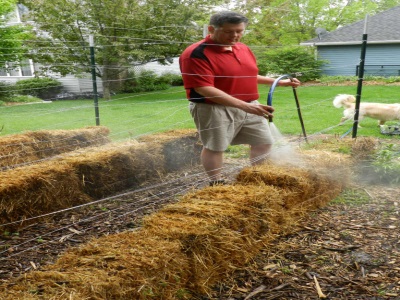
Two prepared bales, top-coated with potting mix. Squash seeds will exist planted here when warm weather arrives.

Stakes and supports
A good manner to support tall plants, such as tomatoes, is with sturdy stakes hammered through the bale and into the ground underneath. Wire tomato cages work for medium-sized plants, such as peppers, eggplants and compact tomatoes, but taller plants can end upward a bit unstable equally they become laden with the harvest and the bales soften.
When growing in straw bales, it'due south worth because compact varieties, which tin can be surprisingly productive.
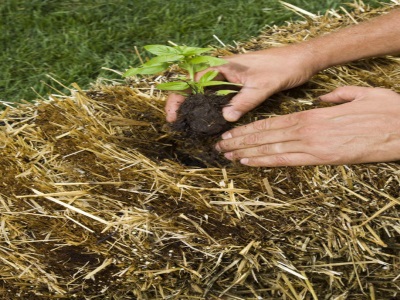
To support alpine plants growing in bales that are placed on a difficult surface, ballast sturdy stakes to the back of the bale.SHOP FOR VEGETABLE SUPPORTS
Care and troubleshooting
Bales can dry out quickly considering they are in a higher place ground and permeable. Be sure to h2o regularly.Drip irrigation or a soaker hose, draped across the pinnacle, piece of work well.

Squash seedlings with mushrooms, which are common early in the season. The harmless mushrooms can be left in place. They volition disappear quickly.
Similarly, regular feeding is important, because frequent watering will lead to nutrient loss more quickly. Feed your crops once a calendar week with a balanced, h2o-soluble plant nutrient.
Because the bales are elevated, it helps deter sure critters, such equally rabbits. I've found slugs to be a bit of a bother to bush beans. A sprinkling of diatomaceous earth helps with this issue.
By the end of the season, the bales will pause down, the extent depends on the crops grown in them and the weather. Some hold up well plenty to establish garlic in the fall. Others collapse into a rich mound of compost, perfect for adding to containers, alteration garden beds or tossing in the compost pile.
Best Plants to Abound in Harbinger Bales
The great affair about harbinger bale gardening is that you can grow merely about anything in a bale that you can in the ground; however, some plants grow better in bales than others. In this chapter, you'll learn which vegetables and fruiting plants thrive all-time in straw bale "soil" and how many of each you can grow per bale.
Plants thatdon'tpractice well in straw
The list of straw-wary plants is pretty slim, so let's start with the few that should be avoided.
Top-heavy plants like standard corn are too tall and heavy—a straw bale may suspension apart nether their weight, or it may topple over. If you do want to grow corn, choose a dwarf variety instead. As the bales naturally raise the plants off the basis by a human foot or ii, top-heavy plants are at risk of beingness blown over by the wind (although adept supports should help to avoid this).
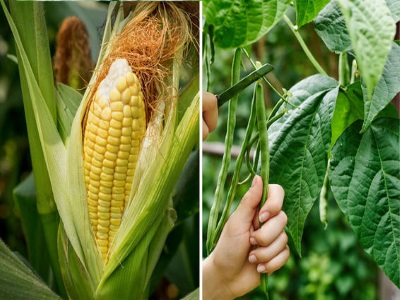
Running plants, or plants that spread past growing "offshoots" with their own roots, can exist hard to manage in a straw bale your outset time around. Save these for your second season.
How to grow tomatoes in straw bales
As a relatively costly fruit to buy, warmth-loving tomatoes are a popular choice with home gardeners everywhere. Tomatoes are a member of the nightshade family and are easy to grow in harbinger bales. Growing them in straw is relatively similar to growing them in earth.
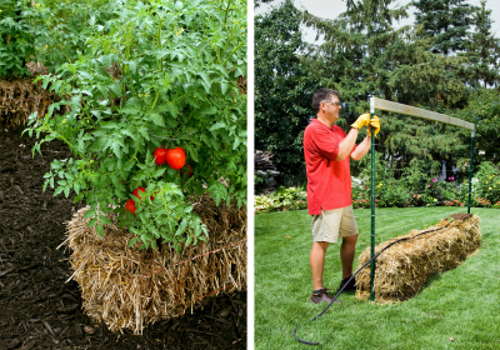
Tomatoes are fantastic harbinger bale candidates and come in almost endless varieties.
Tomatoes demand total sun and will need back up unless you are growing a bushy or tumbling multifariousness with small fruits.
Planting them directly into the bales
Providing it's warm enough, you should have no problem getting your tomatoseeds to germinate and grow if you prefer to plant them directly into the bales. Plant the seeds at the depth specified on the pack, or effectually a quarter of an inch. Nonetheless, tomato plant seeds practise need a temperature range of 70° to 80°F (21° to 27°C) to germinate so you may prefer to start them off in pots in the business firm.
Planting from pots
If you are planting young plants from pots, ensure you lot make a hole deep enough to get all of the roots and an inch or 2 of the stalk into the bale. This is because tomatoes take tiny hairs on their stems, calledadventitious roots, which tin can develop into roots if they come into contact with a growing medium. The result for you is tomato plants with a stronger root organization, which can simply be adept.
Best tomato varieties for harbinger bale gardening
Beginning pocket-sized with the cherry tomato varieties (they weigh less) and, if all goes well, install stronger supports for some beefsteak or brandywine tomatoes for your 2d season.
Some straw-friendly varieties include:
- Sungolds (they're easy to grow and gustatory modality extra-sweet, also!)
- Black cherries (for existent lycopersicon esculentum flavor in a small package)
- Carmellos andstupices: they're groovy mid-sized varieties that won't overwhelm your bales.
Root vegetables and tubers
Root vegetables and tubers are two corking, depression-maintenance options for straw bale gardening. They strive in straw bales because their roots can spread more hands than in dirt and their stems have a much easier time making it to the surface to grow into a found. Root vegetables of all kinds grow best in loose or tilled soil that retains wet but drains easily—that's the very definition of straw.
Reinforce your root veggie bales
Make sure y'all use reinforcements around the bales (like containers or fencing) every bit the root vegetables' growth may weaken the bales over time. Wire fencing, wooden frames, and large containers work perfectly.
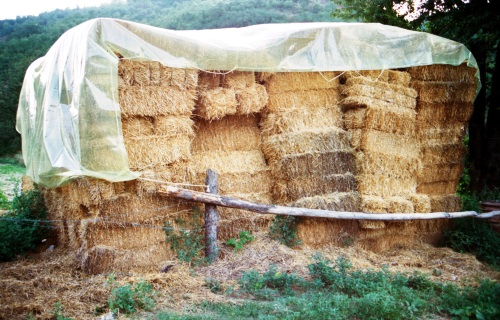
How to abound potatoes in straw bales
Potatoes, the world'due south most well-known tubers, are perfectly suited to harbinger bale gardening. The huge reward of growing potatoes in a straw bale has to practice with depth. Because the baby potatoesclass on the stem, yous would commonly demand to build soil upward around them in order to keep them underground. If you lot plant the potatoes as well deep in soil to begin with, the stem may struggle to achieve the surface and grow into a plant.

Proceed them covered
With straw bale gardening, you tin can avoid this problem because the stems tin can grow more hands up through the straw. Plant your seed potatoes 4-vi inches deep and make sure they are well covered with straw to avoid any light reaching the tubers, every bit this tin can turn them green. Keep covering the stems as they emerge, ensuring that only 1 inch is showing at whatever time.
If that sounds too much like hard work, you can likewise plant the potatoes at a depth of sixteen-18 inches and leave them to information technology.
Early on-maturing varieties such as Yukon Gold or Ruddy Pontiac abound well in straw. Your crop will need a lot less cleaning than potatoes grown in soil – just wipe off the damp straw and you are fix.
Carrots
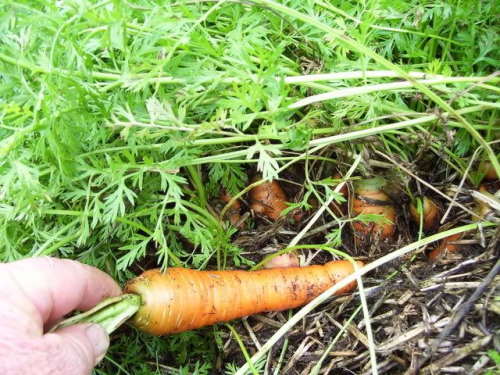
Carrots, like potatoes, are easy to grow in harbinger. They come up in many colorful varieties, from classic orange to white, yellow, and purple. Institute them mid-bound and requite them ii-three months of growing time before harvesting. Considering carrots are easily bruised, it's meliorate to option them with your hands and skip whatever metal tools. To brand this easier, wet the bale shortly earlier harvest and the carrots will slip free much quicker.
Turnips and radishes
The hardy turnip and radish abound well in total sun and can take as little as xxx days to exist fix for harvest. Turnips can exist grown well into October in almost areas, then they're a perfect crop to proceed fresh food on the table as fall's chill sets in. Radishes in particular need full-dominicus areas because, if a nearby constitute blocks even some of its sun, the establish will use all its energy to produce leaves.
Fruiting plants
Fruiting plants are splendid candidates for a straw bale garden. Simply remember that, if it hangs or climbs, information technology needs a support. For your first year, avert extremely tall varieties to avert the claiming of a weakening bale. Endeavour out the plants beneath for a great beginning to your get-go harbinger bale flavor.
Squash:
Yellow squash, zucchini, and other small summer squash varieties are solid (and colorful) options. Make sure you stake them if you don't want them growing into your walkways. Squash plants need a lot of nourishment to thrive, and so condition these bales thoroughly with compost or other food sources before planting.

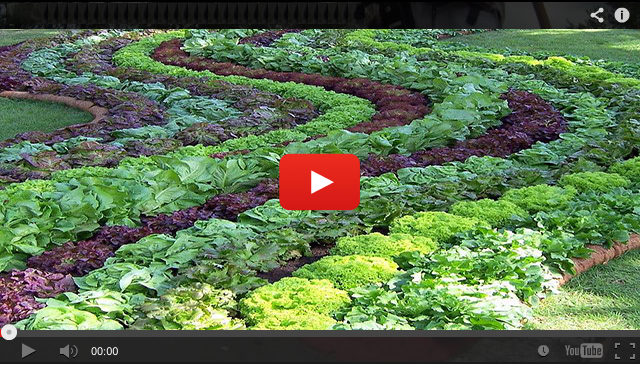
Strawberries:
Put their bale in a sunny spot and institute them in the spring, and y'all'll have a sweetness hay-bale treat waiting for you in a few weeks. Proceed in mind that they demand eight hours of full sun every day to flourish. For all-time results in a harbinger bale, cull a variety that doesn't produce runners; or, if your plant does, clip dorsum the runners so the original plant tin can produce more fruit.
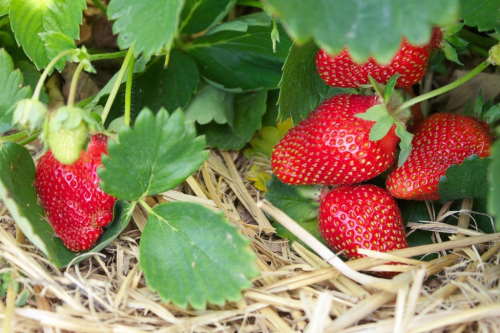
Other good options:
Eggplants, peppers, and other nightshades are great choices with a variety of culinary uses. Just be sure to give them stakes or allow them aplenty room to grow. Eggplants in particular are happiest when they have nigh three and a half months to fully fruit, so plan accordingly.
Leafy greens
Greens, similar root veggies, are like shooting fish in a barrel to abound and perfectly suited to straw bale gardens. Try the classic and versatile greens below to make the most of your growing season.
Lettuce
Lettuce is the archetype salad greenish and tin can be grown in both the spring and fall, but stagger your plantings—information technology grows rapidly. For uninterrupted harvests, constitute new lettuce seeds every 2 weeks. Go along in mind that, if yous reuse the bales, the straw may become also loose subsequently three-4 plantings and y'all'll need to replace them. Lettuce grows all-time with a constant supply of compost and nitrogen-heavy fertilizers, and then add together some to the bale 2-3 weeks afterward each planting.
Spinach, kale, and chard
They're piece of cake to abound and require minimal maintenance. All three tin can grow well into the chilly months for year-round nourishment. They're perfect for salad, sautees, and more, and really help yous brand the most of your harbinger bale space. Plant spinach and kale in the early on jump so again in the fall; they tend to lose their delicious flavor when summer heat sets in. Chard is the nearly versatile of the three: a spring planting will continue you busy harvesting until start frost.
Herbs
Growing your ain flavoring and garnish makes the gardening feel all the more fulfilling, and herbs are just as simple to found and harvest as leafy greens.
Basil
Basil can be used to season a variety of dishes—particularly of the Italian diverseness—but it shouldn't exist planted until after the terminal frost of the season. It grows best in full sunlight, and is ready to harvest once the constitute starts growing buds.
Cilantro
Cilantro (coriander) grows fairly apace and can usually exist harvested four weeks after sowing its seeds. Like nigh herbs, information technology will abound into a healthier plant in full sunlight.
Parsley
Parsley is grown as a leap and summer ingather in most regions. The more than sun it has, the happier (and more flavorful) it'll be.
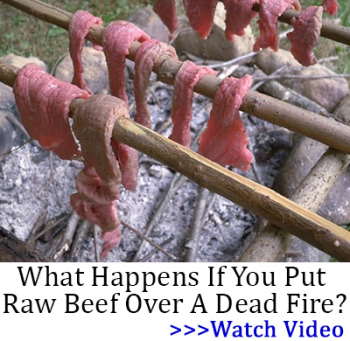
Cruciferous vegetables
Like herbs, cruciferous vegetables are easy growers with a broad assortment of applications. They usually produce well into the fall and winter to assist you extend your growing season.
Cauliflower and broccoli
Cauliflower and broccoli are dandy in-between-flavour crops considering they can be harvested until at least the offset of winter. Plant them equally early every bit late-leap, give them access to total sun, and keep their bales moist, and y'all'll have both delicious and versatile veggies into the winter. These plants grow best when their bales are treated with plenty of nitrogen-rich fertilizer.
Cabbage
Cabbage is best harvested in late autumn, and looks stunning when its leaves burst from a straw bale. Be sure to plant cabbage where it tin can become at least six hours of full sun each day. Like cauliflower and broccoli, information technology does all-time in bales treated with nitrogen-rich fertilizers.
How many plants should y'all plant per bale?
The plants y'all choose will determine how many you can grow in each bale. The seed packet should requite you a guide to spacing only, if in doubt, e'er permit more infinite than you'd expect when you look at the baby plants, and you lot can't go incorrect.
You tin also abound a mixture of plants within each bale, perchance a salad mix of tomato plant, cucumber and lettuce.

When the ability goes out, your safe and comfort is important.
Protect your domicile or business with a new fully automatic standby generator. Maintain your security arrangement, lighting and air conditioning to go along your family or business organisation safety and comfortable through any power outage
Relish the full peace of heed that comes with knowing y'all have a constant and reliable power supply for your dwelling house or concern in with a standby generator from Alternate Ability Solutions . From everyday necessities like heating, cooling, refrigeration and lights, to daily essentials like cooking, laundry or kids bath times. Power outages are occurring more frequently than ever and lasting longer with devastating furnishings.
Stand upward to unpredictable weather and unforeseen outages with the most trusted name in residential standby power with fill-in generators for homes. If the power ever goes out, your General standby generator goes on – automatically – protecting you lot and your dwelling house 24/7.

Books tin be your all-time pre-plummet investment.
Carnivore'due south Bible (is a wellknown meat processor providing custom meat processing services locally andacross the state of Montana and more. Whether your needs are for domestic meator wild game meat processing)
The Lost Book of Remedies PDF ( contains a series of medicinal andherbal recipes to make dwelling house made remedies from medicinal plants and herbs.Chromic diseases and maladies can be overcome past taking the remediesoutlined in this book. The writer claims that his grandfather was taughtherbalism and healing whilst in agile service during world state of war twoand that he has treated many soldiers with his home made cures. )
Like shooting fish in a barrel Cellar (Info about edifice and managing your root cellar, plus printable plans. The volumeon building and using root cellars – The Consummate Root Cellar Book .)
The Lost Ways(Larn the long forgotten secrets that helped our forefathers survive famines,wars,economic crisis and anything else life threw at them)
LOST WAYS 2 ( Wordof the day: Prepare! And do it the old fashion way, similar our fore-fathers did it and succeed longbefore us ,because what lies alee of u.s. will require all the help nosotros can get. Watch this video and larn the 3 skills that ensured our ancestors survival in hard times offamine and state of war.)
SOURCE : https://www.prepperfortress.com/growing-vegetables-in-harbinger-bales-straw-is-like-a-sponge-and-holds-an-amazing-quantity-of-water/
Source: https://beforeitsnews.com/food-and-farming/2022/03/growing-vegetables-in-straw-bales-straw-is-like-a-sponge-and-holds-an-amazing-quantity-of-water-2526731.html
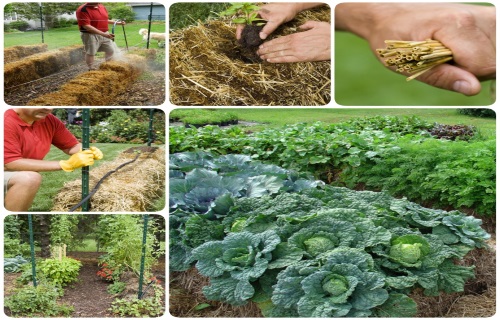
0 Response to "Earthbound Farm, Organic Power Greens, Baby Chard, Kale and Spinach"
Postar um comentário